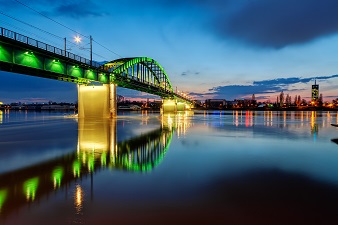Young researchers address Europe’s ageing infrastructure challenges

Related topics
Innovation Funding Researchers Transport Marie Skłodowska Curie actions Smart, green and integrated transport Austria Denmark France Ireland United Kingdom Switzerlanddate: 10/06/2015
Project: Training in European Asset Health Manage...
acronym: TEAM
See also: CORDIS
Behind the TEAM project was a consortium of seven academic and industrial partners from six countries. Together they analysed and sought to improve the processes and technologies used to keep road and rail traffic moving safely, efficiently and sustainably across Europe. The project, a Marie Curie Initial Training Network, carrying out research into different transport asset management strategies, was led by 14 early-stage researchers.
“By producing researchers with an appreciation of all aspects of infrastructure management, we are helping to improve the way the sector is managed in the long term,” explains Ciaran McNally of the UCD School of Civil, Structural & Environmental Engineering at University College Dublin, Ireland.
The researchers are therefore a long-term – and essential – investment in Europe’s future transport infrastructure. Much of Europe’s current road and rail network dates from after World War II, and although many elements have been improved, many sections are straining under ever-increasing transport demand.
McNally, the TEAM project coordinator, says the state of Europe’s infrastructure, particularly bridges, is comparable to the situation in the United States, where an extensive study was carried out following the collapse of the I-35 bridge over the Mississippi River in 2007. The study found that even though more than $10 billion was being invested per year in bridge repairs, the problem was getting worse, with the total bill for all reparations amounting to about $140 billion.
Long-term approach to improving infrastructure management
“It is extremely important that we improve the way European infrastructure is designed and maintained, and develop methods to better allocate limited resources,” McNally notes. “There are no ‘silver bullets’ to the problem, but instead we see ways to incrementally improve our practices.”
The TEAM researchers made use of advanced scientific tools, from mathematical modelling and non-destructive testing to finite element analysis and material characterisation, to study the state of infrastructure across Europe. They deployed new sensor and processing technologies and methodologies to monitor the safety and condition of transport infrastructure, and used these new sources – combined with innovative computer models and algorithms – to generate more accurate assessments.
In the long term, their work should significantly reduce the costs of maintenance and improve road and rail safety by ensuring resources are allocated where they are most needed.
For example, one study by the TEAM researchers looked at the load capacity of long-span bridges, which have traditionally been designed assuming that the critical loading case corresponds to stationary traffic. The study found instead that the critical case corresponds to slow moving traffic – a finding that will enable more targeted bridge designs in the future.
“This knowledge allows us to remove uncertainty from our bridge design codes, which will make the process less conservative and helps us to direct the limited funds to areas where they are really needed,” McNally says. “We have similar examples relating to truck contact pressures on pavements, the development of innovative bridge repair materials, and improved reliability assessment techniques for railway bridges.”
The tools and techniques – and the researchers who developed them – are now being passed into industry, with many of the TEAM students working among the project’s industrial partners, at academic spin-off companies or with other firms.
In addition, some of the partners are involved in a follow-up Marie Curie Initial Training Network, called SUP&R, focused on sustainable pavements and rail lines. They are also preparing to launch another project on structural safety under the European Union’s Horizon 2020 programme.
